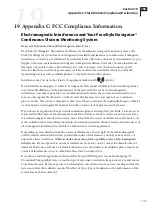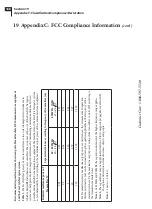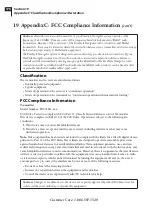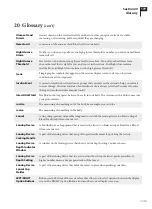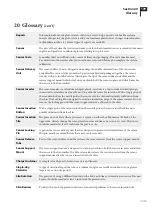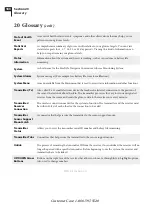
OVER
20 Glossary
(con’t)
Reports
Information about your glucose levels shown in a way to help you and your healthcare team
analyze changes in your glucose levels and your treatment plan (such as changes in insulin doses,
carbohydrate intake, etc.) Several types of reports are available.
Sensor
The part of the system that you insert under your skin. Each inserted sensor is intended to remain
in place and provide a continuous glucose reading for up to 5 days.
Sensor Code
A number that you will find on the sensor delivery unit packaging. This code number must
be entered into the receiver after you insert a new sensor and before you complete the system
calibration.
Sensor Delivery
Unit
The sensor delivery unit is designed and packaged to enable safe insertion of the sensor into
your skin. The sensor delivery unit has 2 parts assembled and packaged together: the sensor
inserter with pre-installed sensor (which puts the tip of the sensor under your skin) and the
sensor support mount (which stays on your skin to hold the sensor in place and which attaches
the sensor to the transmitter).
Sensor Inserter
The sensor inserter is a cylindrical-shaped, plastic-cased device. A pre-cocked, coiled spring is
connected to a stainless steel needle, used to guide the sensor for insertion. With a single push of
the insertion button, the needle guides the sensor into the skin and is quickly withdrawn from
the skin. The Locking Pin is designed to avoid accidental discharge of the sensor inserter. Do not
remove the locking pin until the sensor support mount is adhered to the skin.
Sensor Insertion
Button
With a single push of the insertion button, the needle guides the sensor into the skin and is
quickly withdrawn from the skin.
Sensor Insertion
Site
The place on your body where you insert a sensor, on either the abdomen or the back of the
upper arm. Always change the sensor insertion site each time a new sensor is used. The sensor
should be inserted at least 1 inch from the previous site.
Sensor Locking
Pin
A pin on the sensor delivery unit that was designed to prevent accidental release of the sensor.
This pin must be removed before the sensor can be inserted.
Sensor Release
Tabs
Parts of the sensor delivery unit that release the sensor inserter from the sensor support mount.
Sensor Support
Mount
The sensor support mount is designed to stay on your skin to hold the sensor in place and attach
the sensor to the transmitter. The blue release tabs release the sensor inserter from the sensor
support mount after the sensor is inserted into the skin.
Sharps Container
A safe place for disposal of sensor inserters and lancets.
Single-day
Statistics
A type of statistical report that shows a summary of glucose results in relation to your glucose
targets over a one-day period.
Site Rotation
The practice of using a different location on the body each time you insert a new sensor. The new
Sensor should be inserted at least 1 inch from the previous site.
Skin Barriers
Products that can help prevent irritation or sensitivity problems at the sensor insertion site.
Section 20
179
Glossary
Summary of Contents for FREESTYLE NAVIGATOR
Page 2: ......
Page 4: ......
Page 8: ......
Page 9: ...1 Getting Acquainted ...
Page 23: ...2 Install or Replace Transmitter and Receiver Batteries ...
Page 29: ...3 Set the Time and Date ...
Page 34: ...Customer Care 1 866 597 5520 ...
Page 35: ...4 Perform a Control Solution Test ...
Page 42: ...Customer Care 1 866 597 5520 ...
Page 43: ...5 Insert or Remove Your Sensor ...
Page 54: ...Customer Care 1 866 597 5520 ...
Page 55: ...6 Attach Your Transmitter ...
Page 61: ...7 Calibrate Your System Test Blood Glucose Manually ...
Page 74: ...Customer Care 1 866 597 5520 ...
Page 75: ...8 Set Review or Change the Alarm Settings ...
Page 89: ...9 Daily Use ...
Page 96: ...Customer Care 1 866 597 5520 ...
Page 97: ...10 Respond to Alarms Errors and Problems ...
Page 119: ...11 Add Events ...
Page 125: ...12 Review Reports and Edit Events ...
Page 135: ...13 Clean Your System ...
Page 136: ...Section 13 Key Terms n Receiver n Transmitter n Contact Points Customer Care 1 866 597 5520 ...
Page 139: ...14 Link and Unlink Your Transmitter and Receiver ...
Page 144: ...Customer Care 1 866 597 5520 ...
Page 145: ...15 Reset User Settings ...
Page 146: ...Customer Care 1 866 597 5520 ...
Page 149: ...16 Change Country Settings ...
Page 155: ...17 Appendix A Site Maintenance ...
Page 158: ...Customer Care 1 866 597 5520 ...
Page 159: ...18 Appendix B Specifications ...
Page 173: ...19 Appendix C FCC Compliance Information ...
Page 174: ...Customer Care 1 866 597 5520 164 Section 18 Appendix B Specifications ...
Page 182: ...Customer Care 1 866 597 5520 ...
Page 183: ...20 Glossary ...
Page 184: ...Customer Care 1 866 597 5520 174 Section 19 Appendix C Classification Compliance Declaration ...
Page 191: ...21 Index ...
Page 192: ...Customer Care 1 866 597 5520 ...
Page 195: ......

